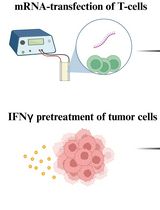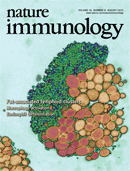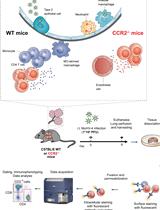- EN - English
- CN - 中文
Mouse CD8+ T Cell Migration in vitro and CXCR3 Internalization Assays
体外小鼠CD8+ T细胞迁移和CXCR3内化测定
发布: 2017年03月20日第7卷第6期 DOI: 10.21769/BioProtoc.2185 浏览次数: 17610
评审: Ivan ZanoniMeenal SinhaYang Fu

相关实验方案

基于 T 细胞的平台,用于对肿瘤浸润 T 细胞的单细胞 RNA 测序数据集中鉴定的 T 细胞受体进行功能筛选
Aaron Rodriguez Ehrenfried [...] Rienk Offringa
2024年04月20日 5766 阅读

研究免疫调控血管功能的新实验方法:小鼠主动脉与T淋巴细胞或巨噬细胞的共培养
Taylor C. Kress [...] Eric J. Belin de Chantemèle
2025年09月05日 2871 阅读
Abstract
Chemokines are molecules that regulate the positioning of cells during homeostasis and inflammation. CXCL10 is an interferon-induced chemokine that attracts cells that express the chemokine receptor CXCR3 on their surface. CXCL10 expression is often induced upon inflammation and guides lymphocytes, such as T and NK cells, into the injured tissues. Notably, CXCL10 binding to CXCR3 induces receptor internalization and, therefore, low CXCR3 levels in cells positive for CXCR3 expression can be indicative of chemokine signaling.
Here, we describe an in vitro method to evaluate the ability of murine CD8+ T cells to migrate towards recombinant murine CXCL10; and a flow cytometry assay to measure CXCR3 expression levels at the surface of T cells, after exposure to different doses of chemokine.
Background
Chemokine-mediated T cell trafficking is an important process during homeostasis and inflammation. Activated CD8+ T cells express chemokine receptors, such as CXCR3, allowing them to migrate towards the chemokines CXCL9, 10 and 11, often upregulated at the injured tissue. The evaluation of molecular cues that modulate T cell migration is important to understand the biology behind their functions but the complex mechanisms operating in vivo are sometimes hard to deconvolve. Here, we provide detailed information on an in vitro method to evaluate chemokine functions on CD8+ T cells, focusing on CXCL10-mediated chemo-attraction and CXCR3 internalization. We use antigen-specific transgenic CD8+ T cells that can be easily expanded and activated in vitro, therefore providing enough number of phenotypically identical lymphocytes (e.g., high chemokine-receptor expression on their surface), required to perform an assay using enough replicates for biologically significant observations and statistical analysis. The cells used per assay originate from one single animal, therefore accounting for reduction of animal usage. This assay is combined with flow cytometry analysis, permitting simultaneous evaluation of 1) number of migrating CD8+ T cells; and 2) phenotypic characterization of chemokine receptor levels on their surface.
Materials and Reagents
- 6 well plate (Fisher Scientific, catalog number: 08-772-33 )
- Sterile pipettes
5 ml (Corning, catalog number: 4051 )
10 ml (Corning, catalog number: 4101 )
25 ml (Corning, catalog number: 4251 ) - 70 μm cell strainer (Corning, catalog number: 431751 )
- 5 ml syringes, without needle (BD, catalog number: 309646 )
- Sterile conical tubes
15 ml (Corning, catalog number: 352099 )
50 ml (Corning, catalog number: 352098 ) - 24 well plate (Corning, catalog number: 353226 )
- Corning® HTS Transwell® 96 well permeable supports, 5.0 μm pore size (Corning, catalog number: 3387 )
- 96 well plates, U bottom (Fisher Scientific, catalog number: 12-565-500 )
- 1.5 ml Eppendorf tubes (Fisher Scientific, catalog number: 05-408-129 )
- Flow cytometry tubes (Round-Bottom Polystyrene Tubes, Corning, catalog number: 352052 )
- CD8+ T cell TCR transgenic mouse, such as OT-1 (C57BL/6-Tg[TcraTcrb]1100Mjb/J, THE JACKSON LABORATORIES, catalog number: 003831 ) or Pmel-1 (B6.Cg-Thy1a/Cy Tg[TcraTcrb]8Rest/J, THE JACKSON LABORATORIES, catalog number: 005023 ) mouse (age 8-12 weeks)
- TCR-specific peptide
If using OT-1 cells – SIINFEKL (AnaSpect, catalog number: AS-60193-1 )
If using Pmel-1 cells – human gp100 (AnaSpec, catalog number: AS-62589 ) - 1x PBS (Thermo Fisher Scientific, GibcoTM, catalog number: 14190144 )
- Recombinant human IL-2 (Miltenyi Biotec, catalog number: 130-097-742 )
- Recombinant murine CXCL10 (Peprotech, catalog number: 250-16 )
- AccuCheck Counting Beads reagent (Thermo Fisher Scientific, Molecular ProbesTM, catalog number: PCB100 )
- RPMI 1640 (Thermo Fisher Scientific, GibcoTM, catalog number: 11875093 )
- Fetal bovine serum (Seradigm, catalog number: 1500-100 )
- Non-essential amino acids (Thermo Fisher Scientific, GibcoTM, catalog number: 11140-050 )
- Sodium pyruvate (Thermo Fisher Scientific, GibcoTM, catalog number: 11360-070 )
- HEPES (Thermo Fisher Scientific, GibcoTM, catalog number: 15630-080 )
- Beta-mercaptoethanol (Thermo Fisher Scientific, GibcoTM, catalog number: 21985-023 )
- Gentamycin (Thermo Fisher Scientific, GibcoTM, catalog number: 15710-064 )
- Hank’s balanced salt solution (HBSS) (Thermo Fisher Scientific, GibcoTM, catalog number: 14025092 )
- Protease-free BSA (GE Healthcare, catalog number: SH30574.02 )
- Mouse CD16/CD32 Fc Blocking antibodies (BD, catalog number: 553142 )
- LIVE/DEAD® Fixable Aqua Dead Cell Stain Kit, for 405 nm excitation (Thermo Fisher Scientific, Molecular ProbesTM, catalog number: L34957 ). Reconstitute each vial with 50 μl of DMSO provided with the kit
- Pacific Blue-conjugated anti-mouse CD3 (clone 145-2C11) (BioLegend, catalog number: 100334 )
- APC-conjugated CD8 (clone 53-6.7) (BD, catalog number: 553035 )
- PE-conjugated CXCR3 (clone CXCR3-173) (BioLegend, catalog number: 126506 )
- R10 media (see Recipes)
- Migration media (see Recipes)
- Blocking buffer (see Recipes)
- Staining mix (see Recipes)
Equipment
- Sterile dissection tools such as small scissors and tweezers (tools can be purchased from Carolina or Sigma, for example)
- Bench-top refrigerated centrifuge (such as Thermo Fisher Scientific, Thermo ScientificTM, model: Thermo ScientificTM SorvallTM LegendTM X1 )
- Incubator (37 °C, 5% CO2, 95% humidity, such as Thermo Fisher Scientific, Thermo ScientificTM, model: Forma Steri-Cycle CO2 incubator )
- Tissue culture hood (Biosafety cabinet, such as The Baker Company, model: SterilGARD e3 )
- Bench-top orbital shaker (such as Thermo Fisher Scientific, model: Thermo Barnstead 4625 Titer Plate Shaker , catalog number: THERMO BARNSTEAD 4625 TITER PLATE SHAKER-1478)
- Optical microscope (such as Leica, model: DM IL LED )
- Neubauer cell counting chamber (such as InCyto, catalog number: DHC-N01 )
- Flow cytometer (such as the BD, model: LSRFortessa )
Software
- Flow cytometer software: DIVA
- Computer analysis software: FlowJo (Treestar)
Procedure
文章信息
版权信息
© 2017 The Authors; exclusive licensee Bio-protocol LLC.
如何引用
Barreira da Silva, R. and Albert, M. L. (2017). Mouse CD8+ T Cell Migration in vitro and CXCR3 Internalization Assays. Bio-protocol 7(6): e2185. DOI: 10.21769/BioProtoc.2185.
分类
免疫学 > 免疫细胞功能 > 淋巴细胞
您对这篇实验方法有问题吗?
在此处发布您的问题,我们将邀请本文作者来回答。同时,我们会将您的问题发布到Bio-protocol Exchange,以便寻求社区成员的帮助。
提问指南
+ 问题描述
写下详细的问题描述,包括所有有助于他人回答您问题的信息(例如实验过程、条件和相关图像等)。
Share
Bluesky
X
Copy link











